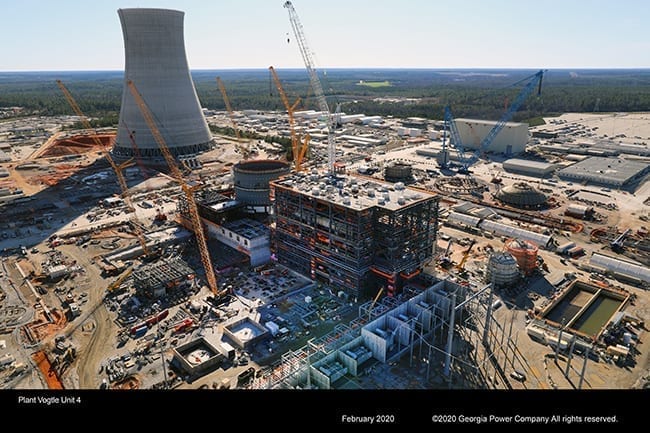Vogtle Workforce Reduced by 20%, but Other Projects Strong in March
The post Vogtle Workforce Reduced by 20%, but Other Projects Strong in March appeared first on POWER Magazine.

The COVID-19 outbreak and efforts to halt the spread of the virus are having a real impact at the Vogtle nuclear expansion construction site, but project starts elsewhere were robust in March.
Cutting Workforce Due to COVID-19On April 15, Georgia Power announced in an 8-K filing with the U.S. Securities and Exchange Commission that it would reduce the workforce at Plant Vogtle Units 3 and 4 by approximately 20%. The reduction was said to be a mitigating action "intended to address the impact of the novel coronavirus ("COVID-19") on the Plant Vogtle Units 3 and 4 workforce and construction site, including ongoing challenges with labor productivity that have been exacerbated by the impact of COVID-19."
The project reported having about 9,000 workers onsite at the end of March, which means about 1,800 people could be directed to stay home. The company expects the reduction to provide operational efficiencies by increasing productivity of the remaining workforce and reducing workforce fatigue and absenteeism. It is also expected to allow for increased social distancing by the workforce and facilitate compliance with the latest recommendations from the Centers for Disease Control and Prevention.
At least 35 workers at the site have reportedly tested positive for COVID-19. Additional workers have been tested and are awaiting results. Georgia Power said the workforce reductions are expected to last into the summer, and it will continue to monitor the effects the coronavirus has on the project.
Another Setback for Long-Delayed ProjectThe Vogtle expansion has experienced numerous delays and cost overruns since the original engineering, procurement, and construction contract was signed in April 2008. Then, the guaranteed substantial completion dates were April 2016 and April 2017 for Units 3 and 4, respectively, and the cost was estimated at $14.3 billion. Now, the regulatory-approved in-service dates are November 2021 and November 2022, respectively, and some estimates have pegged the cost to complete the project at $27 billion or more.
Georgia Power estimated its proportionate share (45.7%) of the incremental cost of the COVID-19 mitigation action would be $15 million to $30 million, "assuming absenteeism rates normalize and the intended productivity efficiencies are realized in the coming months." It does not expect the mitigation action to affect the total project capital cost forecast or its ability to achieve the scheduled in-service dates for the units.
Power Plant Construction Starts Up Despite CoronavirusAlthough construction in general has taken a hit (total construction starts declined 5% from February to March) due to the coronavirus, nonbuilding construction starts rose 14% during the month, due to the start of several large electric power facilities, according to Dodge Data & Analytics, a provider of analytics and software-based workflow integration solutions for the construction industry. The largest nonbuilding project to break ground in March was the $1.0 billion 1,085-MW Indeck Niles Energy Center power plant in Niles, Michigan. Also starting in March were the $600 million Jordan Creek Wind Farm in Williamsport, Indiana, and the $469 million Titan Solar Project in Culberson County, Texas. If the massive 161% gain in the utility/gas plant category were removed from the total, nonbuilding starts would have decreased 9% during the month, the firm said.
"Considering the calamity that occurred towards the end of March as the fallout from the COVID-19 (Coronavirus) hit the economy, construction starts held up rather well," Richard Branch, chief economist for Dodge Data & Analytics, said in a news release. "Construction starts in March were unlikely to be greatly impacted as projects that broke ground during the month likely had materials sourced and in-place and labor booked well ahead of the scheduled groundbreaking. That momentum and planning is difficult to reverse at the last minute. Additionally, most of the stay-at-home orders and construction moratoriums were not instituted until the last week of the month and into April. Therefore, April construction starts are likely to be a very different story with states like New York, New Jersey, and Pennsylvania among others banning construction activity. April's starts data will be the first true indication of how the crisis will impact the construction industry."
-Aaron Larson is POWER's executive editor (@AaronL_Power, @POWERmagazine).
The post Vogtle Workforce Reduced by 20%, but Other Projects Strong in March appeared first on POWER Magazine.